The Roman helmet, known as the Galea, was a vital piece of protective gear for the military of Rome. Not only did it provide an excellent defense on the battlefield, but it also served as a symbol of identity, rank, and achievements within the military hierarchy. The Roman helmet’s strategic design and remarkable construction made it one of the finest armor pieces of ancient times.
Was there more to Roman helmets than just their mere practicality? And how practical were they, actually?
Table of Contents
What is the Roman Helmet?
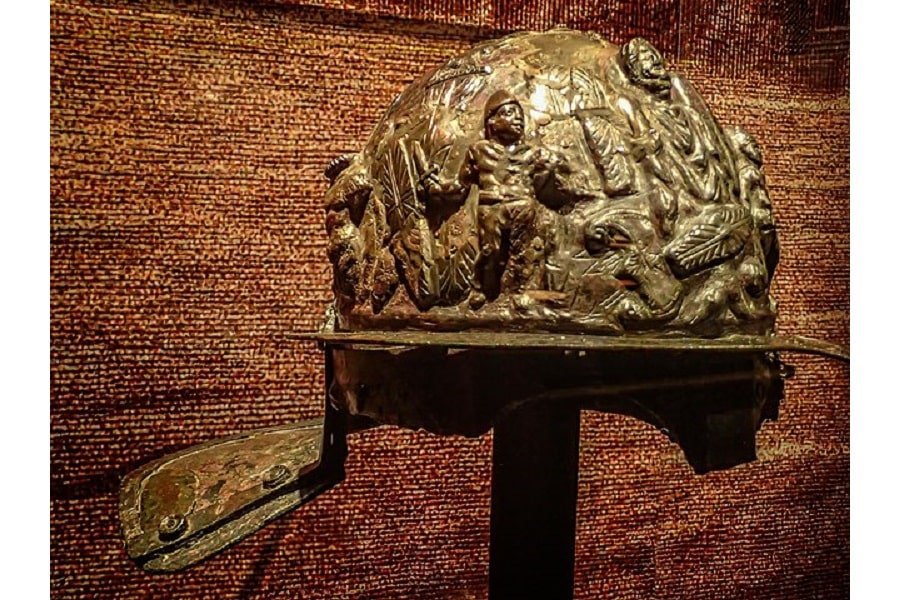
The Roman helmet held immense significance as an essential piece of protective equipment. Its remarkable construction – often decorated with feathers – and strategic design provided the Romans with some of the best armor of ancient times. It brought them defense against a range of battlefield dangers and served as a symbol of identity, rank, and achievements within the military hierarchy.
Roman helmets played a significant role in safeguarding the head from various forms of attacks in the tumultuous battlefields of the Roman Empire. The piece of Roman armor typically featured a rounded shape and was primarily crafted from some sort of metal, often resulting in bronze or iron helmets.
The Roman Empire helmet covered the top, sides, and back of the head, leaving the face exposed for better visibility and communication. Actually, this was quite remarkable for the time. Additionally, the helmet was often decorated with a range of items, including plumes or crests. Not only was this for the sake of aesthetics, but it also served a practical purpose.
Status, Symbolism, and Psyche of the Roman Helmet
Roman helmets provided great defense against direct blows from weapons such as swords, arrows, or blunt objects, significantly reducing the risk of severe head injuries. However, the Roman helmet held a deep symbolic significance, which was a reflection of the soldier’s identity and status.
Status
Different types of helmets were used by various ranks within the Roman army, which allowed for easy identification of officers, flag bearers, or Roman cavalry units.
The design, decorations, and type of crests on the helmets varied based on factors such as rank, unit, and specialization. Your Roman army career was only valid if you had the armor to show for it.
Especially, the addition of the Roman helmet crest – or, cristae – was a common feature to indicate the status of the one wearing the imperial helmet. In the case of Roman helmets, a crest is a decorative feature that runs along the top of the helmet (either vertically or horizontally). Normally, they were made of horsehair or feathers, which were held together with a leather or metal support structure.
High-ranking officers like centurions – who, strangely enough, commanded only 80 soldiers instead of 100 – would wear an impressive crest to show their rank. Centurions wore their cristae in different colors, like red, white, or black. The size of the crest also played a role, further distinguishing ranks within the centurionate.
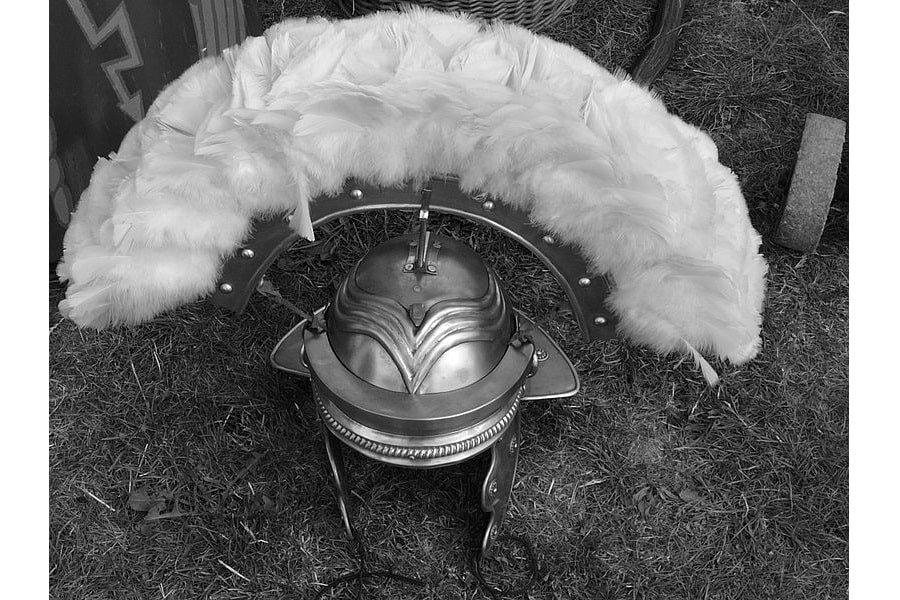
Symbolism
The fact that the helmets were so visually distinct also fostered a sense of pride in the wearers. By wearing a helmet that represented their unit or rank, soldiers identified themselves as part of a larger collective, reinforcing their commitment to their comrades and their shared mission.
Also, the distinctiveness of the helmets made it easier to recognize who belonged to the Roman legion on the battlefield. It helped to minimize confusion in the midst of one of the many battles of the Roman wars. Also, it made the soldiers feel part of a force that could overcome any obstacle.
Psychological Impact
The psychological impact of Roman helmets cannot be understated either. The sight of a legion of soldiers wearing these imposing headpieces had a profound effect on both allies and enemies from the early Roman kingdom onwards.
READ MORE: Roman Legion Equipment
For allies, the helmets created a sense of unity and camaraderie. In turn, the confidence levels among the allies, as well as their loyalty, grew. Being able to recognize someone who is fighting for the same cause from a mile away does instill quite the feeling of togetherness and superiority.
On the other hand, the psychological impact on the opponents of the Romans was probably more striking. The intimidating appearance of Roman helmets struck fear into the hearts of enemies, steadily damaging their morale. The appearance of the helmet really functioned as an additional Roman army tactic.
Still, the psychological impact extended far beyond the battlefield. Roman helmets became synonymous with the might and invincibility of the Roman Empire. As you might know, the Romans were quite good at expanding their territory. Yet still, their reputation preceded them, making Roman soldiers feared and respected across the known world of the time.
READ MORE: The Complete Roman Empire Timeline: Dates of Battles, Emperors, and Events
The reputation of a Roman soldier, at one point, was so intimidating that opponents surrendered without a fight. The effect of the imperial helmet was possibly the largest factor for opponents to do so since it was easily the most recognizable asset of Roman armor.
READ MORE: Roman Weapons: Roman Weaponry and Armor
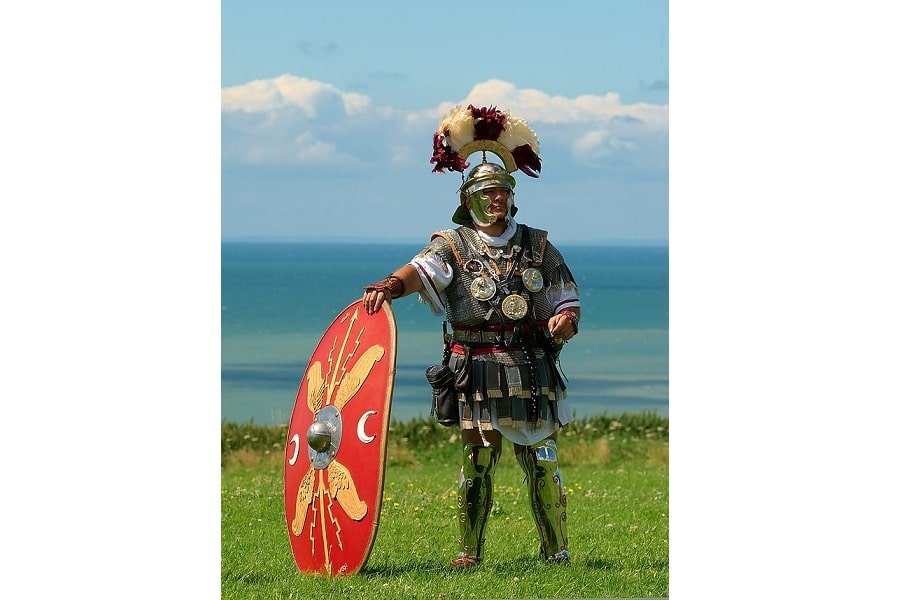
What Were the Features of the Roman Helmet?
The most important parts of a Roman helmet include the overall head coverage, the neck guards and cheek guards, the embossed eyebrows, its elaborate ventilation system, as well as the impressive decorative elements. These features contributed to the helmet’s functionality, practicality, and symbolic significance. The average helmet consisted of four to six plates with straight sides and a rounded bowl to cover the head.
Unlike many helmets of the time, the Roman helmet left the face exposed. This design choice allowed soldiers to maintain clear visibility, which was essential for effective communication and situational awareness on the battlefield. Coordination among troops was quite a bit easier like that since it facilitated the recognition of signals and orders.
Top Notch Coverage
Still, the imperial helmet provided excellent protection to all other parts of the head. It provided extensive coverage, encompassing the top, sides, and back of the head.
This design protected the skull from direct blows, reducing the risk of severe head injuries. The helmet’s construction formed a robust barrier against weapons such as swords, arrows, or blunt objects.
The presence of cheek guards on Roman helmets provided additional protection to the face and sides of the head. Cheek guards shielded vulnerable areas from potential harm. The cheek guards were typically integrated into the helmet’s design.
Sometimes referred to as a ‘neck flap’, the Roman helmets also had a neck guard. They were rather big, which helped to protect the soldier’s neck from sword and spear strikes.
Additionally, the neck guard helped to protect the soldier’s neck from the sun and heat, as well as providing some protection from rain. It also helped to keep the soldier’s neck warm in colder weather. Overall, the large neck guard on Roman helmets was a functional design feature that helped to ensure the soldier’s safety and comfort on the battlefield.
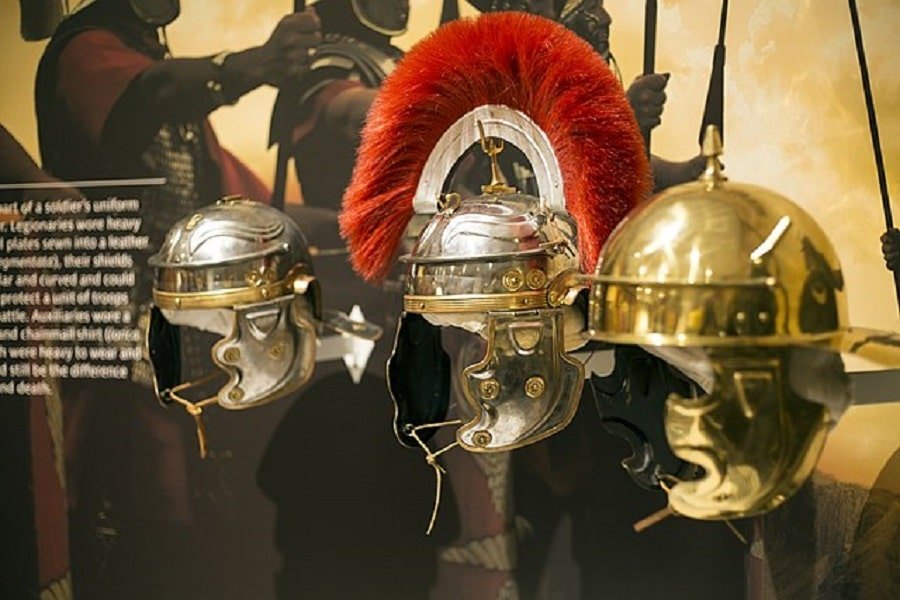
Embossed
Another important feature of the Roman helmets was their embossed eyebrows. These both had practical and symbolic meanings.
Practically, the embossed eyebrows helped to reinforce the structure of the helmet. By adding thickness and rigidity to the front, they provided additional strength to the vulnerable area around the eyeholes. The raised design acted as a reinforcement, deflecting blows and providing enhanced protection against potential glancing blows or projectiles.
An additional advantage of the eyebrows was that they resembled a stern and focused expression, which conveyed a sense of authority and determination. They created an intimidating visage, projecting an image of strength and invincibility to enemies and inspiring confidence and unity among fellow Roman soldiers.
Additional Elements of Roman Helmets
Decorative elements and a holder for the cristae were some other similarities between the Roman helmets over the span of antiquity. Originally, these features belonged to the helmets of a Roman general. Later on, these features also became more widely used in the everyday Roman military helmet.
Additionally, the ventilation of Roman helmets was a widely recognized advantage. The incorporated ventilation systems ensured adequate airflow within the helmet.
The ventilation openings allowed soldiers to breathe comfortably and prevented excessive heat buildup when wearers had to use them for longer periods of time. The proper ventilation contributed to the overall comfort and endurance of soldiers in demanding battle conditions.
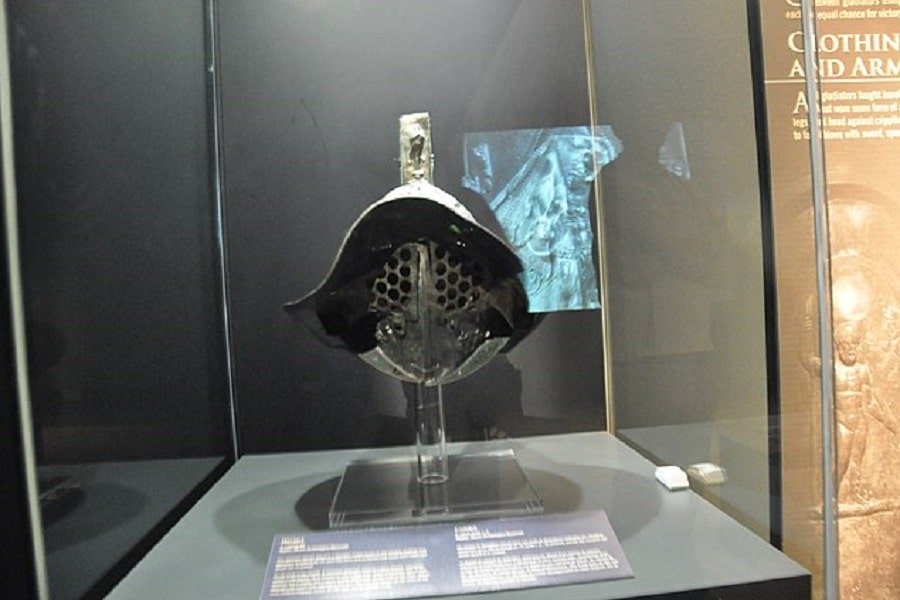
What Types of Roman Helmets Were There?
The Roman Empire saw the development and usage of various types of helmets throughout its history. Two of the most recognized helmets are the Centurion helmet and the Gladiator helmet since they both speak to the illusive might of the Roman legion. The many different helmet designs – over 40 in total – catered to the needs and preferences of different military units, ranks, and time periods.
The design and construction of Roman helmets underwent various transformations and improvements over time. The existence of many different designs wasn’t just trivial. Earlier versions featured simpler designs, while later models incorporated advancements in metallurgy and craftsmanship.
The evolution of Roman helmets mirrored the progress of military technology within the ancient Roman civilization. As the empire expanded and encountered new enemies, the need for advanced protective gear became apparent.
READ MORE: Ancient Civilizations Timeline: The Complete List from Aboriginals to Incans
These advancements resulted in a more sophisticated helmet, which included ventilation and visibility features. Roman blacksmiths and armorers adapted their designs to meet the demands of changing warfare techniques and evolving threats
Centurion Helmets

The Roman Centurion helmet holds a special place in the pantheon of ancient Roman military headgear. This distinctive helmet became a symbol of leadership, authority, and command within the Roman legions.
Its unique design set the Centurions apart from regular soldiers and emphasized their elevated status and responsibilities. The Centurion helmet had a rounded bowl shape, with elaborate cheek guards that provided enhanced protection for the face.
The helmet’s most prominent feature was a large, ornate crest holder at the top, which was often adorned with decorative plumes or feathers. The crest holder on the Centurion helmet was often taller and more elaborate than those found on regular soldier helmets.
The size of the holder reinforced the Centurion’s role as a leader and commander, signifying their authority and presence on the battlefield. The plumes attached to it not only added height to the helmet but also created a striking and impressive visual display. The higher the rank, the more impressive the crest was.
The iconic image of the Centurion helmet has persisted in popular culture, often associated with depictions of ancient Rome and its military might. In films, television shows, and literature set in the Roman era, Centurions are frequently depicted wearing their distinctive helmets, reinforcing the powerful and authoritative image associated with these leaders.
The Centurion helmet remains a lasting symbol of Roman military leadership and continues to inspire admiration and fascination. Its design exemplifies the mastery and attention to detail characteristic of Roman craftsmanship.
Gladiator Helmets

While the average gladiator might’ve been an excellent fighter in the military, the helmets used during the gladiator fights were different from the ones used in the Roman army.
Roman gladiator helmets are among the most iconic and recognizable symbols of ancient Rome. The helmets served a dual purpose, providing protection for the gladiators while also adding to their dramatic appearance – something which seems to be a recurrent theme with Roman helmets.
They came in various styles, each tailored to specific types of gladiators. A well-known style of helmet was the retiarius helmet. This helmet had a distinct fish-like shape, with a large visor of iron bars covering the face and a metal grid or netting at the back to protect the neck.
In addition to their protective and aesthetic qualities, gladiator helmets were also designed to reflect the characteristics and personas of the gladiators themselves. Each type of gladiator had a unique helmet design that reflected their specific fighting style and background.
For example, the helmet of a Thracian gladiator featured a distinctive wide-brimmed visor and a rounded top, representing their origin in Thrace.
Gladiator helmets have become an enduring symbol in popular culture, often associated with the gladiatorial games and ancient Rome. In movies and television shows, gladiator helmets are often reproduced to recreate the spectacle and brutality of the arena.
These depictions have helped popularize the image of the gladiator helmet as an emblem of courage, strength, and the harsh realities of Roman entertainment.
Some Other Roman Helmets
While the Centurion and gladiator helmets were the most recognizable iron helmets from the Romans, there were quite a few other examples.
The designs and features of these helmets evolved over time, reflecting advancements in military technology, the changing needs of the Roman army, and the influences of different regions within the empire. Each type of helmet served a specific purpose, providing protection, identification, and reflecting the wearer’s rank or unit affiliation.
Two of the most prominent remaining Roman helmets were the imperial-type helmets and the ridge-type helmets.
Imperial Helmet
One key distinguishing characteristic of imperial helmets is their elongated and pointed skull shape. Unlike the rounded or conical shapes of other Roman helmets, imperial helmets have a more pronounced and elongated form, resembling the shape of Greek Corinthian helmets.
The Imperial Gallic helmet was one of the most prominent ones in this group, widely used by Roman legionaries during the late Roman Republic and early Roman Empire periods (i.e. between the second century BC and the first century AD).
These Roman helmets had a wide brim that sprouted in the back to form a neck guard. It had a triangular sectioned horizontal rib all the way around the bowl.
This rib may have functioned to increase the rigidity of the Imperial Gallic helmet. Another explanation might be that the helmet consisted of two halves, and the wide brim helped with keeping them together.
The Imperial Italic helmet was another common design for Roman helmets. They resembled the Imperial Gallic helmet but had a more streamlined shape with a narrow brim. The cheek guards were typically integrated into the helmet’s design to make the structure more stable.
Ridge Type Helmets
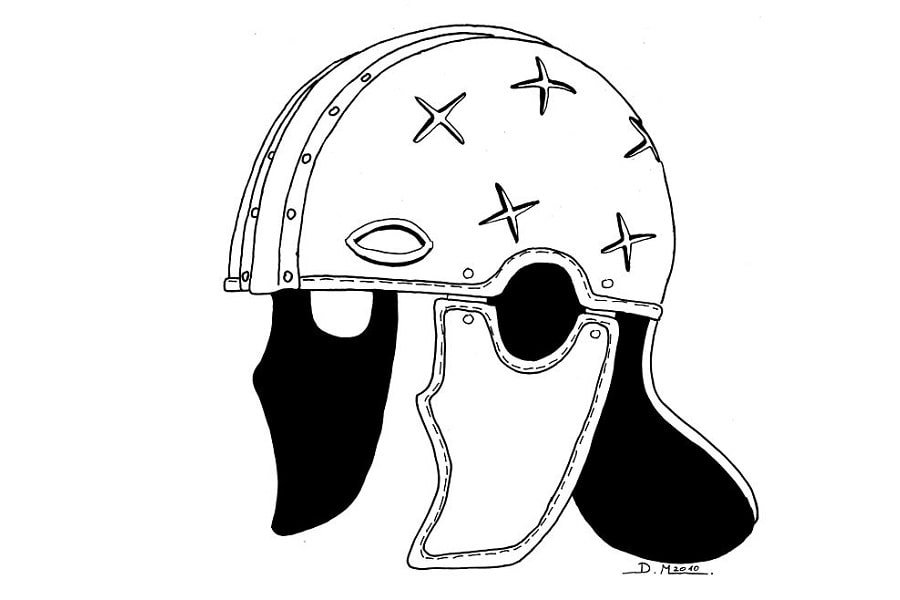
Another common group of helmets was the ridge-type helmets, which included the Intercisa helmet and the Imperial Ridge Helmet. The thing with these Roman helmets was that they didn’t necessarily have a crest: they just had the ridge. This ridge could be made out of iron or another hard material. Overall, it made these Roman helmets more resistant than others.
The Intercisa helmet was a variant of the Imperial Gallic helmet. It was named after the location where a significant number of these helmets were found. The Intercisa helmet had a distinctive shape with a high crest and a clearly visible brow reinforcement.
Another Roman design was the Imperial Ridge helmet, which featured a prominent ridge or crest running from the front to the back. This design provided additional reinforcement and strength to the helmet while offering a unique aesthetic.
Depictions in Popular Culture
Roman helmets have been featured extensively in popular culture. The whole Roman spirit has been subject to the spectacle of Hollywood and beyond.
Films and Television
Roman helmets have been prominently featured in numerous films and television shows that explore the world of ancient Rome. In the film ‘Gladiator’, the iconic Imperial Gallic helmet with its distinctive crest is showcased throughout, creating a visual identity for the soldiers of the Roman army.
Similarly, the TV series ‘Rome’ extensively utilizes Roman helmets to create an authentic atmosphere and bring historical accuracy to its storytelling.
Comic Books
The imagery of Roman helmets has been utilized in comics and graphic novels to convey the power associated with ancient Rome. In the graphic novel series ‘Asterix’, which humorously portrays the Roman Empire’s encounters with the Gauls, Roman soldiers are depicted wearing classic Roman helmets with crests.
Sports Teams and Logos
The symbol of the Roman helmet has been adopted by sports teams, both amateur and professional, to evoke a sense of strength, valor, and competition.
American football teams like the Tampa Bay Buccaneers and the Denver Broncos have incorporated Roman helmet-inspired designs into their logos and uniforms, utilizing the helmet’s visual language to create a connection with ancient warriors and the virtues they represent.
The logo of a hockey team by the name of the Columbus Blue Jackets also incorporates a blue star within a red, white, and blue Roman-style soldier’s helmet.
Lastly, the Italian football club Roma features a logo that incorporates the Roman wolf with two small figures wearing helmets, representing the city’s ancient Roman heritage.